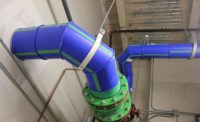The design and construction of the Temecula Valley Hospital in Temecula, Calif., raises the bar for efficient, integrated delivery of health-care facilities. With a design and construction team made up of seven partners that signed a single integrated form of agreement, the five-story, 178,000-sq.-ft. hospital was completed from the ground-up for $157 million — which is 40% below market value.
Efforts related to the building information modeling processes and execution aided in much of the construction efficiencies realized during installation. Combining those benefits with new and innovative contracting methods helped yield best-in-class results and afforded the opportunity to extend the learning and formation of detailed BIM process planning.
The Temecula Valley Hospital has 120 patient beds, 20 intensive care unit beds and six operating rooms, including one cardiovascular operating room. The team began design in January 2010 and the hospital officially opened in October 2013.
Engaging designers
Having engaged mechanical and plumbing designers and builders was very important. With the level of detail required to create prefabricated solutions and, in part, because of the wide array of mechanical and plumbing systems needed to support hospital functions, these systems dominate the above-ceiling spaces. It is critical to recognize the time constraints for high-performing designs and also the coordination that follows.
Once the Temecula project was coordinated, the cost data — made transparent through the IFOA agreement — informed the team that mechanical and plumbing coordination along with BIM pricing nearly doubled the total costs of electrical, sprinkler, framing and drywall, and BIM model management combined.
This affirmed that mechanical and plumbing designers must be more engaged with the creation of BIM processes and more comfortable leading the coordination and BIM process. More specifically, the mechanical and plumbing modelers must truly understand the needs and tasks that shape their modeling process. The level of detail and accuracy required for a near-100% prefabricated installation requires a more robust effort than required of most trades.
The sheer quantity of systems, approaching 10 or 12 on the plumbing side, will also shape the modeling process. It is important the process reflects the unique levels of time and effort required to create effective mechanical and plumbing models, while properly engaging other entities at regular and possibly less frequent intervals.
Improving BIM performance
The Temecula Valley Hospital IFOA allowed the design and BIM teams to explore truly innovative concepts with regard to prefabricated and collaborative construction. Much of the infrastructure that traveled down the corridor path was placed on common racks, eliminating the need for independent hangers per system. Electrical, low-voltage mechanical and plumbing systems shared support systems where possible.
As coordination progressed, modular solutions became more apparent, culminating in a plan to prefabricate the patient restrooms as a single prefabricated or modular element.
Although jurisdictional concerns prevented actual execution, the idea of designing and prefabricating larger sections of infrastructure was deemed worthy amongst the team. Despite tradeoffs between the reduction of labor cost and the material costs generated to support more consistent and repeatable infrastructure installations, designers should still consider working toward more repeatable installations.
Using BIM as a vital component
One of the project goals set forth in the collaboratively created Conditions of Satisfaction (a team charter of sorts) stated that the efforts of the team shall produce labor productivities that were 100% better than industry norms. The BIM process and model components allowed for detailed batching and delivery plans that supported a supremely efficient installation plan.
The model also allowed for the challenging of industry norms when sequencing of work was discussed. In the patient tower, it was agreed that the waste and vent systems would be installed prior to any studs. Using the model as a basis for the discussion, the team agreed that there seemed to be great opportunity in allowing the plumbing work to proceed uninhibited by framing materials or installations. This decision paid off, leading to the realization of more than $200,000 in project cost savings, made fully transparent to the team and owner through the IFOA agreement.
While the decision was certainly the correct one, the process was improved to an even greater degree by the batching and delivery plan that accompanied the installation. The plumbing materials were prefabricated and carted in such a fashion to allow for 5,000 sq. ft. of installation every few days.
The IFOA and BIM model supported team alignment with regard to sequence, batch size and workflow and created a project with very limited peak levels of field labor and the associated chaos that almost always occurs.
Aligning goals
Through the IFOA, Temecula Valley Hospital used integrated lean project delivery to design and build the facility. This created an environment where all significant design and contracting parties had equal incentive to achieve the extremely aggressive targets for cost and scope set by Universal Health Services — the owner of the hospital.
The team, which included Southland Industries, Bergelectric, HMC Architects and a DPR-Turner joint venture, aligned its goals by guaranteeing direct costs, but requiring each partner to place its profit into a shared, at-risk pool to incentivize performance and value. This environment fostered true innovation, trust and collaboration.
Early in the design process, the team agreed to a 14-ft., floor-to-floor height in the patient tower to minimize the overall height and cost related to skin and structure. This placed significant pressure on the design and BIM teams to spatially coordinate the intricate array of MEP and infrastructure systems to support the highly technical hospital requirements. The IFOA and big-room environment initiated by the partners allowed for collaborative discussions and processes to take place, while ensuring a well-coordinated, yet fully maintainable installation.
Inform your architect
One of the most valuable lessons learned during the design and coordination of the Temecula Valley facility is related to the quality of data generated during architectural modeling. As contracting becomes more collaborative, earlier efforts should be placed on informing architects of the true construction dimensioning and detailing required; thus creating a process in which the architectural model can be used by the trades, rather than copied and refined.
For instance, engaging the plumbing and framing designers early in the process will enable them to create real plumbing fixture models, complete with the adjacent framing and drywall components for use in the architectural model. The data contained in the creation of this element will spare the design and construction teams from working through various wall-thickness and fixture- placement issues.
The integrated project delivery method implemented at Temecula Valley created an optimal environment to challenge some of the traditional BIM processes in place. The transparency with which each party was able to execute the work allowed for much of the process to be immediately altered if potential improvements to the processes were identified and planned.
The lessons learned through the integrated delivery of this project will significantly alter approaches to BIM and trade coordination in the future.
Author bio: Ken Lindsey is a contract executive and preconstruction lead for Southland Industries, has experience in lean construction fundamentals and has been a member of four IPD teams over the last five years. Lindsey has 14 years of experience in the design and construction of HVAC and plumbing projects in Southern California. He can be reached at klindsey@southlandind.com




